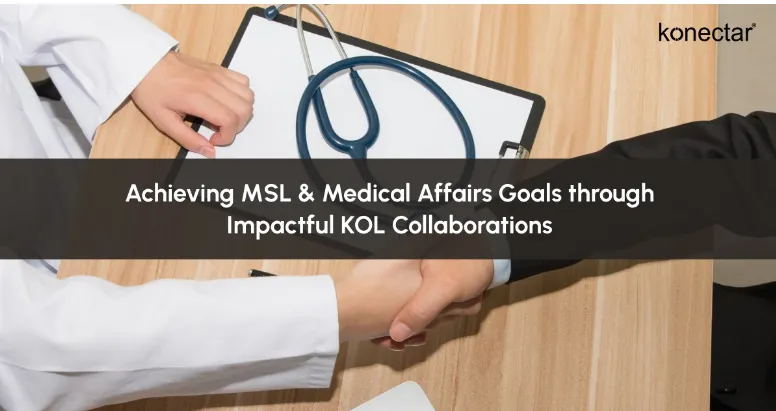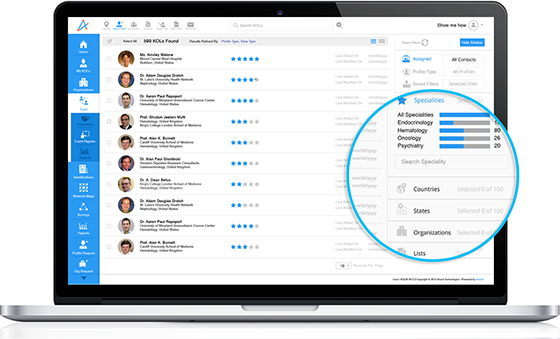18-09-2024
Achieving MSL & Medical Affairs Goals through Impactful KOL Collaborations

The success of the life sciences industry depends on how well its therapies contribute to the improvement in the well being and health of individuals worldwide. While various factors come into play when designing and implementing a clinical trial and developing new therapies, the life sciences teams comprising, often the Medical Affairs and MSLs collaborate with Key Opinion Leaders (KOLs) in healthcare.
In this article:
KOLs, known for their influence and expertise guide the life sciences teams in their specific objectives such as driving research, devising new therapies and innovations for improving patient outcomes.
Medical Affairs teams and MSLs on the other hand are responsible for collaborating with KOLs for advancing scientific knowledge and appropriate therapies, supporting clinical trial initiatives and . However, achieving these objectives requires a strategic and cohesive approach to engaging with KOLs. By fostering a unified approach, organizations can enhance the effectiveness of their KOL engagement efforts, drive meaningful scientific discussions, and ultimately achieve their medical and business objectives.
The Importance of KOL Engagement for Life Sciences Teams
Aligning KOL strategies with MSL and Medical Affairs goals is essential for creating a cohesive, efficient, and impactful approach to medical communications and engagements. Without alignment, there is a risk of disjointed messaging, missed opportunities, and inefficient resource allocation. Hence, it becomes essential for life sciences organizations to identify relevant KOLs who align with their specific objectives.
Various Methods of Identifying KOLs
KOL identification depends on the objectives for which they need to be engaged for. Historically, factors such as HCPs’ contributions to research, clinical experience, and their visibility within medical communities are taken into account. A common way to identify KOLs is by analyzing their publication record. KOLs often have extensive research published in peer-reviewed journals, clinical guidelines, and articles, making them highly visible in the academic and clinical world.
KOLs are also great speakers or presenters who often present at key medical conferences. Their involvement in leading discussions on clinical developments, case studies, or therapeutic breakthroughs highlights their influence. Life sciences teams manually track conference speaker lists to identify KOLs.
For organizations looking for principal investigators (PIs), clinical trials databases are searched to find key investigators associated with ongoing and completed studies. While these traditional methods are valuable, they can be time-consuming, manual, and prone to oversight.
Using AI-Powered Tools for Efficient KOL Identification and Management
Modern AI-powered tools have transformed the process of KOL identification, making it more efficient, data-driven, and precise. Unlike traditional methods that rely on manual tracking and subjective peer recommendations, AI-driven platforms leverage natural language processing (NLP) and machine learning algorithms to scan and analyze large datasets from sources like scientific publications, clinical trial registries, social media, and conference presentations.
They analyze vast amounts of data across multiple channels in real-time, providing deeper insights into a KOL's influence and relevance.
How konectar Revolutionizes KOL Engagement?
konectar, an AI-powered HCP management platform, is transforming how life sciences companies identify and engage with KOLs and HCPs. By delivering deep, data-driven insights, konectar enables organizations to connect with the most relevant experts in their therapeutic areas with speed and precision.
With real-time intelligence on research developments, industry events, and expert activities, konectar ensures companies stay ahead in their outreach strategies. This smarter, more strategic approach strengthens relationships, enhances engagement, and drives impactful collaborations—helping life sciences companies navigate the evolving healthcare landscape with confidence.
Medical Conference Tracking: A Key to KOL Identification
Medical conferences and events are critical venues for KOL engagement. They offer a platform for healthcare professionals, researchers, and thought leaders to share insights and discuss emerging trends. Advanced AI-powered tools, such as konectar’s Medical Event Tracking Module, provide MSLs and Medical Affairs teams with a more streamlined, data-driven approach to identifying KOLs and planning their event participation. Here’s how:
By identifying high-value conferences, tracking key sessions, and analyzing speaker influence in real time, teams can focus their efforts where they matter most. Advanced insights enable better planning, more meaningful interactions, and informed post-event strategies—ensuring that every engagement drives stronger relationships and impactful collaborations.
To enhance your success in the life sciences industry through strategic collaboration with the right KOLs, explore the comprehensive suite of konectar modules. Gain some actionable insights into the KOL landscape and revolutionize your decision-making process. For more information or to schedule a personalized demo, reach out to us today!





